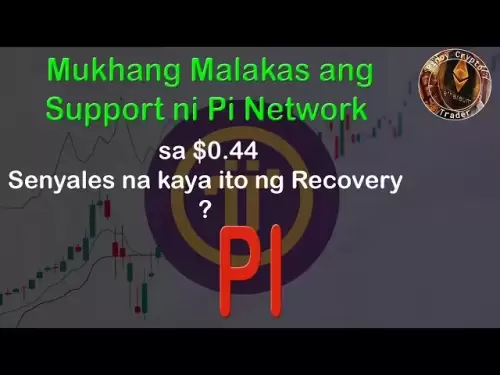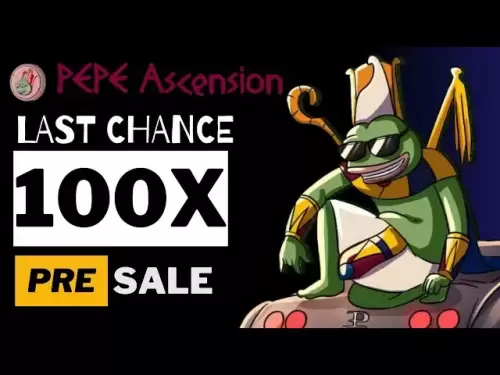-
 Bitcoin
Bitcoin $108,894.1122
0.78% -
 Ethereum
Ethereum $2,576.7002
2.37% -
 Tether USDt
Tether USDt $1.0000
-0.02% -
 XRP
XRP $2.2743
0.90% -
 BNB
BNB $662.6529
1.20% -
 Solana
Solana $152.3741
3.18% -
 USDC
USDC $1.0000
0.01% -
 TRON
TRON $0.2865
0.68% -
 Dogecoin
Dogecoin $0.1718
4.83% -
 Cardano
Cardano $0.5873
2.01% -
 Hyperliquid
Hyperliquid $39.7211
2.09% -
 Sui
Sui $2.9080
0.43% -
 Bitcoin Cash
Bitcoin Cash $495.0930
2.00% -
 Chainlink
Chainlink $13.6045
3.29% -
 UNUS SED LEO
UNUS SED LEO $9.0692
0.54% -
 Avalanche
Avalanche $18.2226
2.15% -
 Stellar
Stellar $0.2486
3.70% -
 Shiba Inu
Shiba Inu $0.0...01176
1.99% -
 Toncoin
Toncoin $2.7908
-7.52% -
 Hedera
Hedera $0.1594
3.69% -
 Litecoin
Litecoin $87.8847
1.25% -
 Monero
Monero $318.2718
0.86% -
 Polkadot
Polkadot $3.3962
1.17% -
 Dai
Dai $0.9999
-0.01% -
 Ethena USDe
Ethena USDe $0.9999
-0.02% -
 Bitget Token
Bitget Token $4.4102
0.34% -
 Uniswap
Uniswap $7.3795
1.39% -
 Aave
Aave $286.7121
5.74% -
 Pepe
Pepe $0.0...01007
3.39% -
 Pi
Pi $0.4602
2.28%
What should I do when UNI's 30-day annualized volatility decreases?
When UNI's 30-day annualized volatility decreases, reassess your investment strategy, consider diversifying your portfolio, and adjust your trading approach accordingly.
Apr 25, 2025 at 02:14 pm
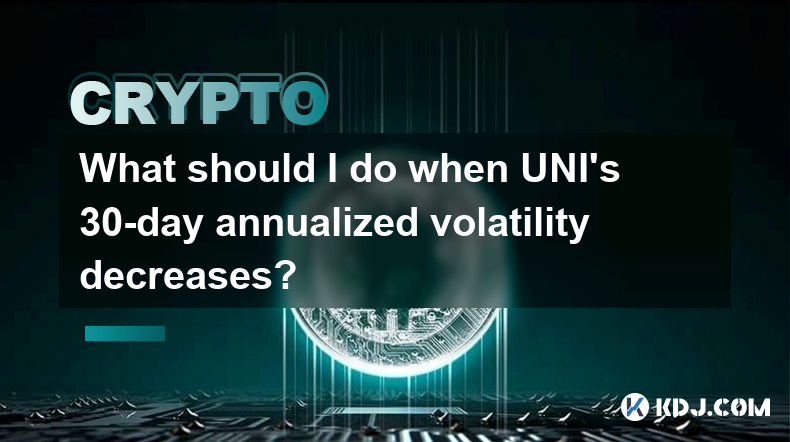
When UNI's 30-day annualized volatility decreases, it's important to understand the implications and consider potential actions based on your investment strategy. Volatility is a measure of the price fluctuations of an asset over time, and a decrease in volatility can signal a change in market conditions that might affect your investment decisions.
Understanding UNI's Volatility
UNI, the native token of the Uniswap decentralized exchange, can experience varying levels of volatility. The 30-day annualized volatility is a metric that annualizes the standard deviation of the token's daily returns over a 30-day period. A decrease in this volatility means that the price movements of UNI have become more stable over the recent period. This stability could be due to various factors such as market sentiment, regulatory news, or shifts in trading volume.
Analyzing the Market Context
Before taking any action, it's crucial to analyze the broader market context. Look at other cryptocurrencies and market indicators to see if the decrease in UNI's volatility is part of a larger trend. For instance, if the overall crypto market is also experiencing lower volatility, it might indicate a period of consolidation or a shift towards more stable trading conditions. Conversely, if UNI's volatility is decreasing while other assets remain volatile, it could be a sign of specific factors affecting UNI alone.
Assessing Your Investment Strategy
Your next step should be to reassess your investment strategy in light of the decreased volatility. If you're a long-term investor, a period of lower volatility might be a good time to hold or even increase your position in UNI, as the risk of large price swings is reduced. However, if you're a short-term trader, you might find fewer opportunities for profit due to the smaller price movements.
Diversifying Your Portfolio
In response to decreased volatility, consider diversifying your portfolio. If you have a significant portion of your investments in UNI, you might want to spread your risk by investing in other cryptocurrencies or assets. Diversification can help you manage risk and potentially increase returns, especially in a market where one asset's volatility is decreasing.
Adjusting Your Trading Strategy
If you're actively trading UNI, a decrease in volatility might require you to adjust your trading strategy. Here are some steps you can take:
- Review your trading indicators: Ensure that your technical indicators are still relevant in the new volatility environment. You might need to adjust your moving averages, RSI, or other tools to better suit the current market conditions.
- Consider different trading strategies: With lower volatility, strategies like range trading or scalping might become more effective. These strategies focus on smaller price movements and can be profitable in a less volatile market.
- Set tighter stop-losses: Since price movements are smaller, you can set tighter stop-loss orders to protect your capital while still allowing for potential gains.
- Monitor market sentiment: Keep an eye on news and social media to gauge market sentiment. Even in a low volatility environment, sentiment can shift quickly and affect UNI's price.
Evaluating Risk Management
Decreased volatility can also be an opportunity to re-evaluate your risk management practices. With lower risk of large price swings, you might feel more comfortable taking on slightly more risk in other areas of your portfolio. However, always ensure that your risk management strategies are aligned with your overall investment goals and risk tolerance.
Considering Long-Term Holdings
For those holding UNI as a long-term investment, a decrease in volatility can be a positive sign. Stable price movements can indicate that the asset is maturing and becoming more accepted in the market. This stability can be reassuring for long-term holders, as it suggests a lower risk of significant losses.
Monitoring for Reversal Signals
While decreased volatility can be a sign of stability, it's important to monitor for potential reversal signals. Even in a low volatility environment, the market can shift quickly. Keep an eye on key support and resistance levels, as well as any significant news or developments that could affect UNI's price. Being prepared for a potential increase in volatility can help you react quickly and protect your investments.
FAQs
Q: How can I tell if the decrease in UNI's volatility is temporary or a long-term trend?
A: To determine if the decrease in UNI's volatility is temporary or a long-term trend, you should monitor the volatility over an extended period. Look at historical data to see if there are patterns of volatility decreasing and then increasing again. Additionally, keep an eye on market news and developments that could influence UNI's price stability.
Q: Should I sell my UNI holdings if the volatility decreases?
A: Whether to sell your UNI holdings when volatility decreases depends on your investment strategy and goals. If you're a long-term investor, holding through periods of lower volatility might be beneficial. However, if you're looking for short-term gains, you might consider selling if you believe the market conditions are not favorable for your trading strategy.
Q: Can decreased volatility in UNI affect other cryptocurrencies in my portfolio?
A: Yes, decreased volatility in UNI can affect other cryptocurrencies in your portfolio, especially if they are closely correlated with UNI. For example, if UNI is a significant part of the decentralized finance (DeFi) ecosystem, a decrease in its volatility might influence other DeFi tokens. Always consider the interconnectedness of the crypto market when making investment decisions.
Q: What tools can I use to monitor UNI's volatility?
A: There are several tools you can use to monitor UNI's volatility. Platforms like CoinGecko and CoinMarketCap provide historical price data and volatility metrics. Additionally, trading platforms often offer volatility indicators and charts that can help you track UNI's price movements and volatility over time.
Disclaimer:info@kdj.com
The information provided is not trading advice. kdj.com does not assume any responsibility for any investments made based on the information provided in this article. Cryptocurrencies are highly volatile and it is highly recommended that you invest with caution after thorough research!
If you believe that the content used on this website infringes your copyright, please contact us immediately (info@kdj.com) and we will delete it promptly.
- Babylon, Bitcoin, and the EVM Mainnet: A New Era for BTCFi?
- 2025-07-07 16:30:11
- Queen Elizabeth Coin Sells for £31,000: A Royal Fortune in Your Pocket?
- 2025-07-07 16:30:11
- XRP Price Check: Will Resistance Trigger a July Drop?
- 2025-07-07 17:10:12
- UAE, Toncoin, and Golden Visas: Separating Fact from Crypto Fiction
- 2025-07-07 16:50:12
- Toncoin, UAE, and the Golden Visa Mirage: What Really Happened?
- 2025-07-07 17:10:12
- Toncoin's UAE Visa Saga: Hype, Hope, and the Inevitable Pullback
- 2025-07-07 17:15:11
Related knowledge
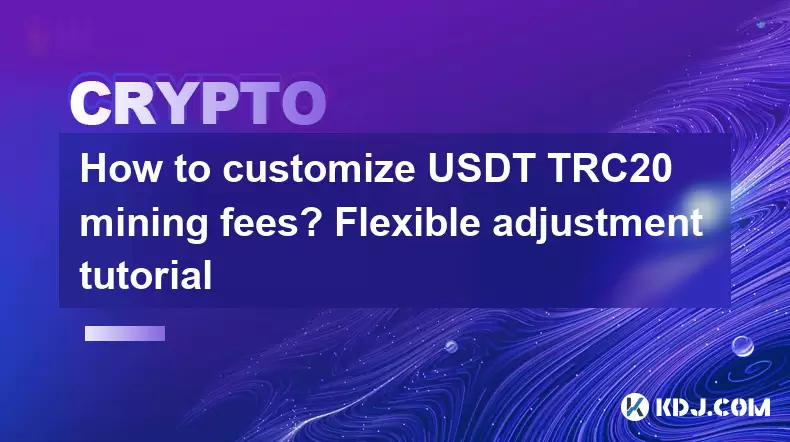
How to customize USDT TRC20 mining fees? Flexible adjustment tutorial
Jun 13,2025 at 01:42am
Understanding USDT TRC20 Mining FeesMining fees on the TRON (TRC20) network are essential for processing transactions. Unlike Bitcoin or Ethereum, where miners directly validate transactions, TRON uses a delegated proof-of-stake (DPoS) mechanism. However, users still need to pay bandwidth and energy fees, which are collectively referred to as 'mining fe...
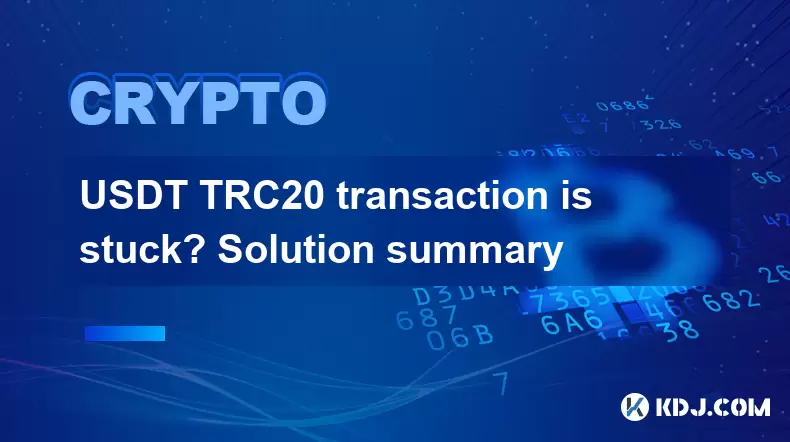
USDT TRC20 transaction is stuck? Solution summary
Jun 14,2025 at 11:15pm
Understanding USDT TRC20 TransactionsWhen users mention that a USDT TRC20 transaction is stuck, they typically refer to a situation where the transfer of Tether (USDT) on the TRON blockchain has not been confirmed for an extended period. This issue may arise due to various reasons such as network congestion, insufficient transaction fees, or wallet-rela...
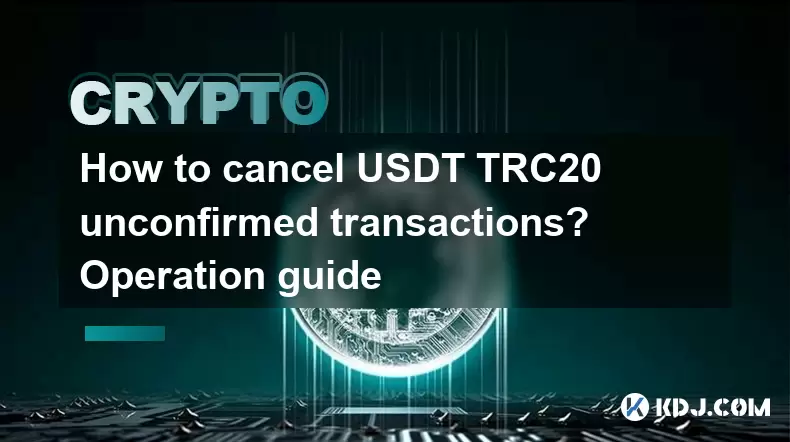
How to cancel USDT TRC20 unconfirmed transactions? Operation guide
Jun 13,2025 at 11:01pm
Understanding USDT TRC20 Unconfirmed TransactionsWhen dealing with USDT TRC20 transactions, it’s crucial to understand what an unconfirmed transaction means. An unconfirmed transaction is one that has been broadcasted to the blockchain network but hasn’t yet been included in a block. This typically occurs due to low transaction fees or network congestio...
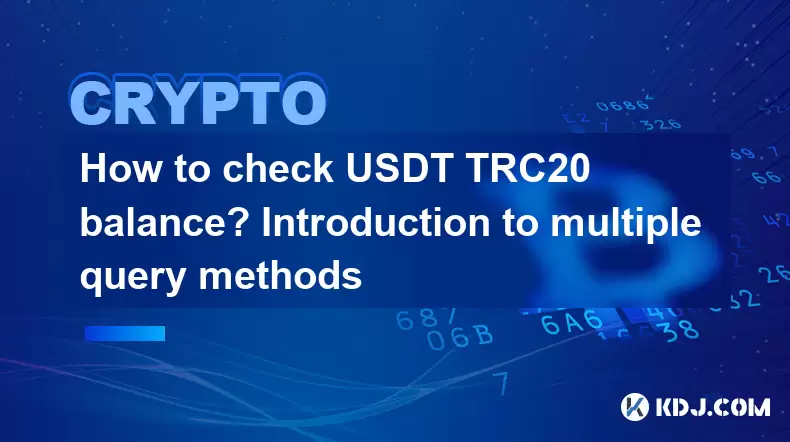
How to check USDT TRC20 balance? Introduction to multiple query methods
Jun 21,2025 at 02:42am
Understanding USDT TRC20 and Its ImportanceUSDT (Tether) is one of the most widely used stablecoins in the cryptocurrency market. It exists on multiple blockchain networks, including TRC20, which operates on the Tron (TRX) network. Checking your USDT TRC20 balance accurately is crucial for users who hold or transact with this asset. Whether you're sendi...
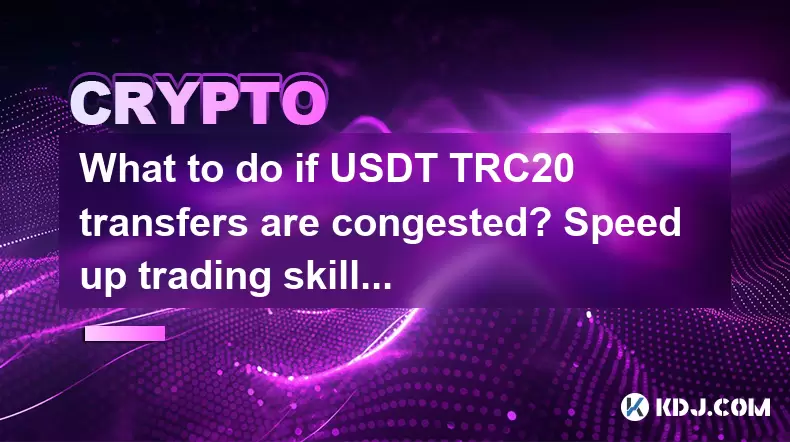
What to do if USDT TRC20 transfers are congested? Speed up trading skills
Jun 13,2025 at 09:56am
Understanding USDT TRC20 Transfer CongestionWhen transferring USDT TRC20, users may occasionally experience delays or congestion. This typically occurs due to network overload on the TRON blockchain, which hosts the TRC20 version of Tether. Unlike the ERC20 variant (which runs on Ethereum), TRC20 transactions are generally faster and cheaper, but during...
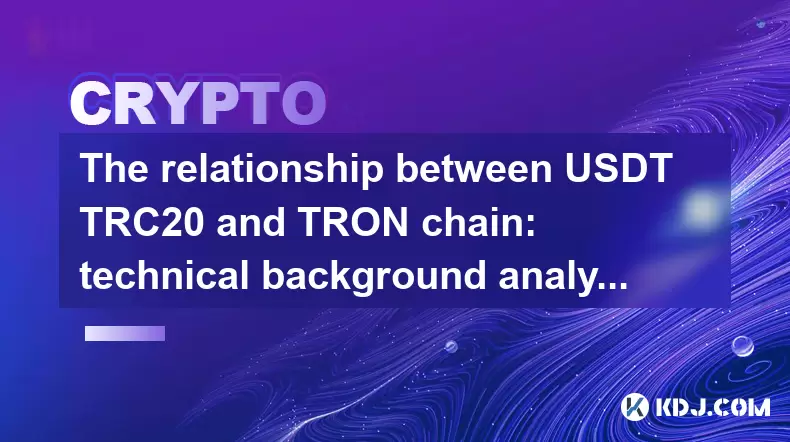
The relationship between USDT TRC20 and TRON chain: technical background analysis
Jun 12,2025 at 01:28pm
What is USDT TRC20?USDT TRC20 refers to the Tether (USDT) token issued on the TRON blockchain using the TRC-20 standard. Unlike the more commonly known ERC-20 version of USDT (which runs on Ethereum), the TRC-20 variant leverages the TRON network's infrastructure for faster and cheaper transactions. The emergence of this version came as part of Tether’s...

How to customize USDT TRC20 mining fees? Flexible adjustment tutorial
Jun 13,2025 at 01:42am
Understanding USDT TRC20 Mining FeesMining fees on the TRON (TRC20) network are essential for processing transactions. Unlike Bitcoin or Ethereum, where miners directly validate transactions, TRON uses a delegated proof-of-stake (DPoS) mechanism. However, users still need to pay bandwidth and energy fees, which are collectively referred to as 'mining fe...

USDT TRC20 transaction is stuck? Solution summary
Jun 14,2025 at 11:15pm
Understanding USDT TRC20 TransactionsWhen users mention that a USDT TRC20 transaction is stuck, they typically refer to a situation where the transfer of Tether (USDT) on the TRON blockchain has not been confirmed for an extended period. This issue may arise due to various reasons such as network congestion, insufficient transaction fees, or wallet-rela...

How to cancel USDT TRC20 unconfirmed transactions? Operation guide
Jun 13,2025 at 11:01pm
Understanding USDT TRC20 Unconfirmed TransactionsWhen dealing with USDT TRC20 transactions, it’s crucial to understand what an unconfirmed transaction means. An unconfirmed transaction is one that has been broadcasted to the blockchain network but hasn’t yet been included in a block. This typically occurs due to low transaction fees or network congestio...

How to check USDT TRC20 balance? Introduction to multiple query methods
Jun 21,2025 at 02:42am
Understanding USDT TRC20 and Its ImportanceUSDT (Tether) is one of the most widely used stablecoins in the cryptocurrency market. It exists on multiple blockchain networks, including TRC20, which operates on the Tron (TRX) network. Checking your USDT TRC20 balance accurately is crucial for users who hold or transact with this asset. Whether you're sendi...

What to do if USDT TRC20 transfers are congested? Speed up trading skills
Jun 13,2025 at 09:56am
Understanding USDT TRC20 Transfer CongestionWhen transferring USDT TRC20, users may occasionally experience delays or congestion. This typically occurs due to network overload on the TRON blockchain, which hosts the TRC20 version of Tether. Unlike the ERC20 variant (which runs on Ethereum), TRC20 transactions are generally faster and cheaper, but during...

The relationship between USDT TRC20 and TRON chain: technical background analysis
Jun 12,2025 at 01:28pm
What is USDT TRC20?USDT TRC20 refers to the Tether (USDT) token issued on the TRON blockchain using the TRC-20 standard. Unlike the more commonly known ERC-20 version of USDT (which runs on Ethereum), the TRC-20 variant leverages the TRON network's infrastructure for faster and cheaper transactions. The emergence of this version came as part of Tether’s...
See all articles























